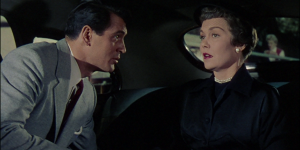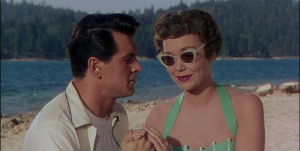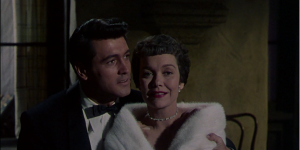Ben-Hur (1959)
Tuesday, February 17th
8:00PM (ET)
 Set around the birth and life of Christ, Judah Ben-Hur (Charlton Heston) through a series of brief encounters is an observer of Christ’s life and death. However, this is not about the life of Christ, rather an epic centered on a man seeking revenge. Judah Ben-Hur’s life has been one of privilege, as a Jewish trader he has connections to Romans who occupy Judea. One such being his childhood friend Messala (Stephen Boyd) who has returned to Judea as commander of the Roman garrison. Messala believes in the power of Rome and attempts his friendship with Ben-Hur to gain information about the Jewish inhabitants. Ben-Hur refuses to be disloyal to his people and his faith. Thus, setting up these two old friends to become bitter rivals both fighting for their own beliefs and loyalties.
Set around the birth and life of Christ, Judah Ben-Hur (Charlton Heston) through a series of brief encounters is an observer of Christ’s life and death. However, this is not about the life of Christ, rather an epic centered on a man seeking revenge. Judah Ben-Hur’s life has been one of privilege, as a Jewish trader he has connections to Romans who occupy Judea. One such being his childhood friend Messala (Stephen Boyd) who has returned to Judea as commander of the Roman garrison. Messala believes in the power of Rome and attempts his friendship with Ben-Hur to gain information about the Jewish inhabitants. Ben-Hur refuses to be disloyal to his people and his faith. Thus, setting up these two old friends to become bitter rivals both fighting for their own beliefs and loyalties.
 During the parade for the new governor of Judea, Valerius Gratus (Mino Doro), a loose tile falls frightening the governors horse and killing him. In protecting his sister, Ben-Hur is accused of the crime and it is his old friend Messala who sends Ben-Hur to a miserable existence as a galley-slave, a fate which ensures his certain death. But this is not the end of Ben-Hur who in another series of events, saves the Roman consol Quintus Artius (Jack Hawkins). Artius adopts Ben-Hur as his son, giving him all the rights and privileges or a Roman citizen. Ben-Hur now travels back to Judea to confront the man who ruined his life and his family, all culminating into one of the largest action sequences on film, a great chariot race.
During the parade for the new governor of Judea, Valerius Gratus (Mino Doro), a loose tile falls frightening the governors horse and killing him. In protecting his sister, Ben-Hur is accused of the crime and it is his old friend Messala who sends Ben-Hur to a miserable existence as a galley-slave, a fate which ensures his certain death. But this is not the end of Ben-Hur who in another series of events, saves the Roman consol Quintus Artius (Jack Hawkins). Artius adopts Ben-Hur as his son, giving him all the rights and privileges or a Roman citizen. Ben-Hur now travels back to Judea to confront the man who ruined his life and his family, all culminating into one of the largest action sequences on film, a great chariot race.
 Ben-Hur (1959) would not only be known for the great chariot race sequence, but also for the fact that it saved MGM from bankruptcy. MGM needed a way to pull movie goers away from their television sets at home. MGM also had reserves of funds in the way of movie profits in foreign countries that could only be spent in the respective countries. MGM decided to use some of these profits to film a grand epic set in the time of ancient Rome, Quo Vadis (1951). It was then decided that they would reuse the sets and costumes from Quo Vadis for another Roman epic, a remake of MGM’s 1925 epic film, Ben-Hur. Even prior to 1925, Ben-Hur: A Tale of Christ was a popular book written by Lew Wallace and published in 1880. Until this point, Wallace had been a lawyer, a general in the United States Army, and a judge at the trial of the assassins of Abraham Lincoln. He had dreamed of becoming a writer, and wrote Ben-Hur while serving as governor of New Mexico. The book was later turned into a stage play which ran from 1899-1921 consisting of a water battle and chariot race.
Ben-Hur (1959) would not only be known for the great chariot race sequence, but also for the fact that it saved MGM from bankruptcy. MGM needed a way to pull movie goers away from their television sets at home. MGM also had reserves of funds in the way of movie profits in foreign countries that could only be spent in the respective countries. MGM decided to use some of these profits to film a grand epic set in the time of ancient Rome, Quo Vadis (1951). It was then decided that they would reuse the sets and costumes from Quo Vadis for another Roman epic, a remake of MGM’s 1925 epic film, Ben-Hur. Even prior to 1925, Ben-Hur: A Tale of Christ was a popular book written by Lew Wallace and published in 1880. Until this point, Wallace had been a lawyer, a general in the United States Army, and a judge at the trial of the assassins of Abraham Lincoln. He had dreamed of becoming a writer, and wrote Ben-Hur while serving as governor of New Mexico. The book was later turned into a stage play which ran from 1899-1921 consisting of a water battle and chariot race.
 Charlton Heston was the not the first choice for the role of Judah Ben-Hur, the role was originally offered to an array of Hollywood lead actors including: Burt Lancaster, Paul Newman, Marlon Brando, Rock Hudson, Geoffrey Horne, Leslie Nielsen, and Kirk Douglass. However, Heston at this point was no stranger to epic films starring in Cecil B. DeMille’s final two films, The Greatest Show on Earth (1952) and The Ten Commandments (1956). The later probably providing him sufficient background and insight that would benefit him in his Academy Award winning role of Ben-Hur.
Charlton Heston was the not the first choice for the role of Judah Ben-Hur, the role was originally offered to an array of Hollywood lead actors including: Burt Lancaster, Paul Newman, Marlon Brando, Rock Hudson, Geoffrey Horne, Leslie Nielsen, and Kirk Douglass. However, Heston at this point was no stranger to epic films starring in Cecil B. DeMille’s final two films, The Greatest Show on Earth (1952) and The Ten Commandments (1956). The later probably providing him sufficient background and insight that would benefit him in his Academy Award winning role of Ben-Hur.
 Ben-Hur was the highest grossing film of 1959 and the second highest grossing film of all-time behind Gone with the Wind (1939). It is the perfect picture to watch in honor of Oscar season. The film though nominated for 12 awards, would win 11 awards at the 32nd Academy Awards in 1960 a record that would be matched later by Titanic (1997) and The Lord of the Rings: Return of the King (2003):
Ben-Hur was the highest grossing film of 1959 and the second highest grossing film of all-time behind Gone with the Wind (1939). It is the perfect picture to watch in honor of Oscar season. The film though nominated for 12 awards, would win 11 awards at the 32nd Academy Awards in 1960 a record that would be matched later by Titanic (1997) and The Lord of the Rings: Return of the King (2003):
- Best Picture- Sam Zimbalist
- Best Director- William Wyler
- Best Actor in a Leading Role- Charlton Heston
- Best Actor in a supporting Role- Hugh Griffith
- Best Art Direction- Set Direction, Color- Edward C. Carfagno & William A Horning, Hugh Hunt
- Best Cinematography, Color- Robert L. Surtees
- Best Special Effects- Arnold Gillespie, Robert Macdonald & Milo Lory
- Best Film Editing- John D. Dunning & Robert E. Winters
- Best Music, Scoring of a Dramatic or Comedy Picture- Miklós Rózsa
- Best Sound Recording- Franklin Milton



































